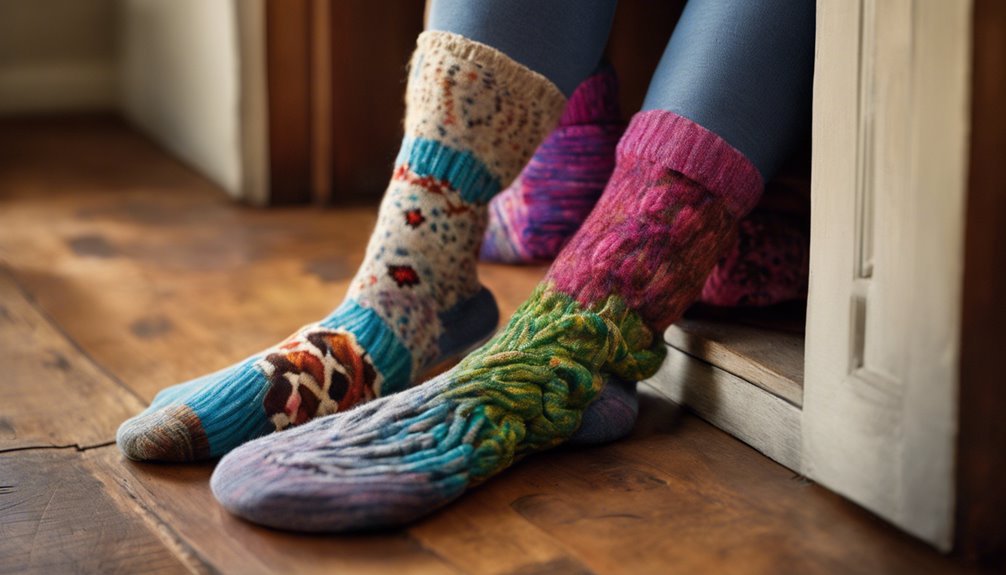The Secret Hack of Using Socks to Prevent Door Drafts
Imagine this: It's a chilly winter evening, and you're curled up on the couch, blanket wrapped around you, when suddenly, a cold draft sneaks in through the door, sending a shiver down your spine.
Have you ever noticed how even the slightest draft can disrupt the cozy warmth of your home? Using socks to block door drafts is a clever and budget-friendly solution to boost your home's energy efficiency.
Gather thick socks and fill them with rice or dried beans, securing them tightly to form a snug barrier against airflow. Make sure they extend past the door edges for ideal sealing.
Prioritize socks made from insulated materials like wool, and experiment with different fillers for the best fit. Enhance results by combining with weatherstripping—there's a lot more you can discover.
Understanding Door Drafts and Their Impact

When it comes to maintaining energy efficiency in your home, door drafts can be a significant concern. Identifying air leakage is essential for enhancing door insulation and reducing energy costs. First, inspect the gaps around your door frames. Use a smoke pen or incense stick to detect air flow; movement indicates leakage. For precise insulation, apply weatherstripping tape along the edges. Choose materials like silicone or rubber for flexibility and durability. Additionally, install a door sweep at the bottom to seal gaps effectively. Verify the door fits snugly within its frame by adjusting hinges if necessary. By addressing these elements, you'll minimize drafts, optimize insulation, and guarantee your home remains comfortable. Embrace this freedom to control your environment and energy consumption efficiently.
Why Socks Make an Effective Draft Stopper
Socks, particularly those that have lost their partners or are worn beyond regular use, can serve as an efficient and cost-effective solution for blocking drafts under doors. The dense fabric of socks provides excellent insulation, trapping air and reducing heat loss. For those seeking DIY solutions, this method allows you to repurpose materials without the constraints of purchasing specialized products. Simply roll or stuff socks to create a compact barrier that snugly fits the door gap.
Use thicker socks for best performance, as their increased bulk enhances the draft-stopping effect. Confirm that the sock draft stopper extends beyond the door edges to prevent air seepage. This approach not only maximizes thermal efficiency but also offers a sense of autonomy in managing your home's comfort.
Step-by-Step Guide to Creating a Sock Draft Stopper

You'll need a pair of thick socks, some rice or dried beans, and a sewing kit to create an effective sock draft stopper. Begin by filling the sock with your chosen material, ensuring it's evenly distributed, then securely stitch the open end closed to prevent any spillage. For ideal placement, position the stopper snugly against the door gap to block drafts without hindering door movement.
Materials and Tools Needed
Crafting a sock draft stopper is an efficient way to keep chilly drafts at bay while upcycling old socks. Begin with the right socks selection; choose thicker socks, like wool or fleece, for ideal insulation. Confirm they're long enough to cover the door gap. For DIY materials, gather uncooked rice, beans, or sand for filling, providing weight and flexibility. You'll also need a sturdy needle, strong thread, and scissors for sewing. An optional funnel can aid in filling precision, making sure no mess. Consider fabric glue if sewing isn't your preference—it offers a quick, no-sew alternative. Don't forget a ruler or measuring tape to verify your draft stopper fits snugly across the door. These materials and tools empower you to create with freedom.
Assembly and Placement Tips
Before you begin assembling your sock draft stopper, make sure your materials are ready and workspace is organized for efficiency. Start by aligning your chosen socks flat, making certain no wrinkles. Fill them with rice or sand for weight and flexibility, leaving room for tying. Seal the open end securely with a strong knot or stitch. Precision in sock assembly guarantees ideal draft blocking.
| Step | Action | Tip |
|---|---|---|
| 1 | Lay socks flat | Make sure no wrinkles |
| 2 | Fill with rice/sand | Leave space for tying |
| 3 | Seal ends | Use strong knot or stitch |
For placement techniques, position the draft stopper snugly against the door's base. Adjust its length by folding or adding socks to fit various door sizes. This adaptability maximizes efficiency.
Choosing the Right Socks for the Job
When selecting socks for your draft stopper, prioritize material that offers durability and insulation, like wool or thick cotton blends. Guarantee the socks are long enough to cover the door's width and can be easily packed with filler for proper weight and structure. While color and style may seem trivial, choosing a sock that complements your decor guarantees the draft stopper blends seamlessly into your space.
Material Matters Most
Selecting the right material is essential when using socks to prevent door drafts. For ideal insulation properties, consider socks made from wool or fleece. These materials are renowned for their excellent thermal retention, ensuring your space stays warm and cozy. Wool, with its natural fibers, offers breathability while effectively trapping heat. Fleece, on the other hand, provides a synthetic alternative that mimics similar insulating abilities. When exploring sock types, avoid thin materials like cotton, as they lack the necessary density to block drafts efficiently. Instead, opt for thicker, well-padded socks that can provide a robust barrier against cold air. Remember, the choice of material not only impacts effectiveness but also your comfort and flexibility in maintaining a draft-free environment.
Size and Fit
To guarantee ideal draft prevention, it's crucial to choose socks that fit snugly around the door without leaving gaps. Start by measuring sock dimensions to confirm they match your door's width and height. For a precise fit, consider these expert tips:
- Measure Your Door: Determine both the height and width to find socks that cover the entire gap.
- Select the Right Sock Size: Opt for socks that are slightly longer than the door's width for a secure wrap.
- Fit Adjustment: Use stretchable materials to accommodate any minor size discrepancies.
- Layering Technique: If one sock isn't enough, layer multiple socks for enhanced insulation.
With the right fit, you'll maintain warmth while embracing the freedom of a cozy, draft-free space.
Color and Style
Color and style might seem trivial, but they play a pivotal role in choosing the right socks for door draft prevention. Start by selecting sock patterns that complement your home's aesthetic. Stripes, argyle, or polka dots can add a touch of whimsy, while solid colors offer a minimalist approach. Color coordination is essential; choose shades that blend seamlessly with your floor or door color to maintain visual harmony. For a more discreet solution, consider neutral tones like beige or gray. If you're feeling adventurous, opt for a bold color to create a statement piece. Remember, these socks aren't just functional; they're an opportunity to express your personal style. So, embrace the freedom to experiment and let your creativity shine through even in draft prevention.
Additional Tips for Maximizing Draft Prevention
While addressing door drafts with socks is effective, enhancing draft prevention involves additional strategies that can further insulate your space. To maximize efficiency, consider implementing these expert tips:
- Creative Sock Designs: Choose socks with vibrant patterns that complement your decor. Not only will they block drafts, but they'll also add a stylish touch to your space.
- Eco Friendly Materials: Opt for socks made from sustainable fibers. They offer warmth and reduce environmental impact, aligning with a lifestyle of freedom and responsibility.
- Layering Technique: Double up on socks or add a layer of cloth inside for increased thickness, further blocking cold air.
- Seal Gaps: Apply weatherstripping to frame edges. This guarantees your sock stoppers work in harmony with a tightly sealed doorway.
Benefits of Using Sock Draft Stoppers

Even though sock draft stoppers might seem like a simple solution, they offer numerous benefits that can greatly improve your home's energy efficiency. By using sock draft stoppers, you create an effective draft insulation barrier against cold air seeping through door gaps. This simple hack helps maintain a consistent indoor temperature, reducing the need for excessive heating or cooling and ultimately slashing your energy bills. One of the key sock benefits is their flexibility; you can easily adjust the stoppers to fit any door size. For ideal performance, fill the sock with materials like rice or sand for added weight and seal. This not only prevents drafts but also enhances soundproofing and keeps out unwanted pests, granting you freedom from discomfort.
Frequently Asked Questions
How Often Should I Replace My Sock Draft Stopper?
On average, socks last about 1-2 years. For ideal draft prevention, replace your sock draft stopper every year. Check for wear and tear; loss in sock longevity can reduce effectiveness. Maintain freedom from drafts with regular updates.
Can Sock Draft Stoppers Be Used on Windows?
Absolutely, sock window draft stoppers can be effective. Measure your window's width, tightly fill socks with rice or beans, secure ends, and place them snugly against gaps. This simple draft prevention method provides flexibility and energy savings.
Are There Any Downsides to Using Sock Draft Stoppers?
When considering sock draft stoppers, assess their effectiveness in blocking airflow. While practical, they might not fit your aesthetic preferences. Opt for neutral or decorative socks to maintain style freedom without compromising on functionality or energy efficiency.
Can I Use Old, Worn-Out Socks for Draft Stoppers?
Did you know 30% of home energy loss happens through doors? Repurpose old socks by filling them with dense sock materials like rice or sand for effective draft prevention. Embrace freedom, save energy, and stay cozy.
How Do I Clean a Sock Draft Stopper?
To clean your sock draft stopper, first determine sock materials. For cotton, use gentle cycle with mild detergent. Air-dry to avoid shrinkage. For synthetic, hand wash using lukewarm water. This method guarantees durability, letting you enjoy unrestricted comfort.







